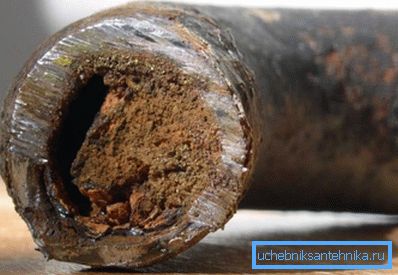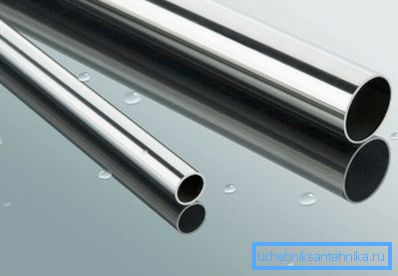Plumbing steel pipe: advantages and technical
Steel always remains steel. And, despite the abundance of more practical and cheaper alternatives, steel pipes are still in fairly high demand due to their some simply unique qualities. About them and will be discussed in this article.

Weigh Pros and Cons
But let's not be unfounded and go directly to the pros and cons of this product:
Merits
- Steel water pipes according to GOST 10704 91 have a very high resistance to mechanical stress. This is the most durable material used in plumbing, so if you need to lay a pipeline under the floor, under the roadway, under high internal pressure or in even more extreme situations, steel products will be the best choice.
- Relatively low price. Of course, the pipeline from this material does not come out the cheapest, but one of the budget can be called. Moreover, there is still an accessibility factor. After all, if you need to build a small section of the water supply system, then you will not accidentally find a metal bay at the site, but the steel segment may well be found.
- A wide range of auxiliary valves. Metal corners, tees, adapters and other parts necessary for creating an optimal water supply system are always in large quantities present on the shelves of specialty stores.

- Low thermal expansion. This is a very important parameter for pipes, if you plan to hide them in a screed or plaster, since if it is high, this will lead to rapid cracking of the coating layer.
- High resistance to temperature extremes. The steel pipeline will transfer any temperatures that are possible in domestic conditions, which allows it to be safely installed on the hot water supply or in the heating system.

disadvantages
We will be objective and consider immediately and all the minuses accompanying the operation of the products in question:
- Susceptibility to corrosive processes. Rust destroys metal, especially for cold water supply lines, where condensate often falls on the surface of iron due to the difference in temperature with the external atmosphere.

Tip: Immediately after the installation of steel water supply, apply a primer and paint on it. This will protect the metal from the effects of condensate and premature rusting.
- Reducing the internal diameter. Over time, build-ups build up over time, closing the passage, which also does not occur without the participation of corrosive processes.

Tip: it is recommended to install special filters at the joints of the metal pipeline, which will slow down the formation of growths.
- Complicated installation instructions. You will either need the services of a welder, or you will have to cut the threads with dies. Both options are time consuming and expensive, but we will consider them in more detail.

- Great weight. Significantly complicates the transportation and installation of pipes. In addition, excessive severity requires reliable fastening in case of fixation on the wall and exerts an additional load on the foundation.
Upgraded options
As can be seen from the negative aspects of steel, the greatest problem is its susceptibility to corrosive processes. This problem can be solved by using more expensive, but at the same time, improved material:
Galvanized

The process of manufacturing such products is as follows: a conventional steel pipe is sprayed with zinc using the electromechanical method from the inside and outside.
This immediately eliminates two drawbacks:
- It eliminates the possibility of rust.
- Growth cease to form inside the pipeline.
The service life of steel water pipes in this case increases many times.
Stainless steel

This material is formed by adding various materials to the metal. What comes out of it will last a very long time.
But it is worth bearing in mind the two minuses of stainless steel:
- Very high cost.
- The complexity of processing. This is a very durable material.
Main settings
The range of steel water pipes operates with the following values:
| Characteristic | Description |
| Internal section | This is the most important defining characteristic of all pipe products, including fittings. |
| Outside diameter | External diameters of steel water pipes are divided into three classes:
|
| Nominal diameter | The nominal value of the internal cross section in millimeters. |
| Wall thickness | The difference between inner and outer diameters. |
GOST for steel pipes for water supply involves the presence of three options with respect to wall thickness:
- Lungs. Used only for gas pipeline.
- Ordinary. The most common when laying water systems.
- Reinforced. Required under pressure. Accordingly, they stand and weigh more, which is unacceptable in standard situations.

Size chart of steel water pipes look like this:
| Section inches | Conditional pass, mm | Outer diameter, mm | Ordinary | Reinforced | ||
| Wall width, mm | Weight per meter, kg | Wall width, mm | Weight per meter, kg | |||
| 1/4 | 6 | 13.5 | 2.25 | 0.62 | 2.75 | 0.73 |
| 3/8 | ten | 17 | 2.25 | 0.82 | 2.75 | 0.97 |
| 1/2 | 15 | 21.25 | 2.75 | 1.25 | 3.25 | 1.44 |
| 3/4 | 20 | 26.75 | 2.75 | 1.63 | 3.5 | 2.01 |
| one | 25 | 33.5 | 3.25 | 2.42 | four | 2.91 |
| one ? | 32 | 42.25 | 3.25 | 3.13 | four | 3.77 |
| one ? | 40 | 48 | 3.5 | 3.84 | 4.25 | 4.58 |
| 2 | 50 | 60 | 3.5 | 4.88 | 4.5 | 6.16 |
| 2? | 70 | 75.5 | 3.75 | 6.64 | 4.5 | 7.88 |
| 3 | 80 | 88.5 | four | 8.34 | 4.75 | 9.81 |
| four | 100 | 114 | four | 10.85 | five | 13.44 |
| five | 125 | 140 | 4.5 | 15.04 | 5.5 | 18.24 |
| 6 | 150 | 165 | 4.5 | 17.81 | 5.5 | 21.63 |
The dimensions of the water steel pipe according to GOST are easily selected for any needs, it is enough just to check the table, which should also be available for each seller of a specialized store.
The standard service life of steel water pipes is forty years of continuous work with proper maintenance, which includes timely painting and cleaning the inside.
Connection options
There are two ways to install steel pipelines:
Welding

Pros:
- Guarantees maximum tightness.
- It is carried out in rather short terms.
Minuses:
- Requires expensive welding equipment and handling skills.
- Eliminates the possibility of dismantling without cutting pipes.
- In the case of the use of galvanized products, the protective zinc layer in the place of welding breaks.
Thread

Pros:
- Does not require expensive equipment, enough high-quality pipe dies.
- Installation does not require such specific skills as the use of a welding machine. Cutting thread on the pipe to learn much easier.
- Subsequently it is possible to dismantle the pipeline without causing damage to the pipes themselves.
Minuses:
- Requires additional sealing of the joints in the form of a winding from FUM tape or tow.
- The process itself is very laborious and time consuming.
Conclusion
The table of diameters of steel water pipes will always help you choose the right products for your pipeline. As can be judged from the above, metal remains in demand in plumbing and to this day primarily due to its unique strength properties. And if you take care of its protection from corrosive processes, then the created water supply system will serve you for a long time and efficiently.

The video in this article will introduce you to additional materials that are directly related to the topic under consideration. Where high resistance to mechanical stress is needed, only steel will help.